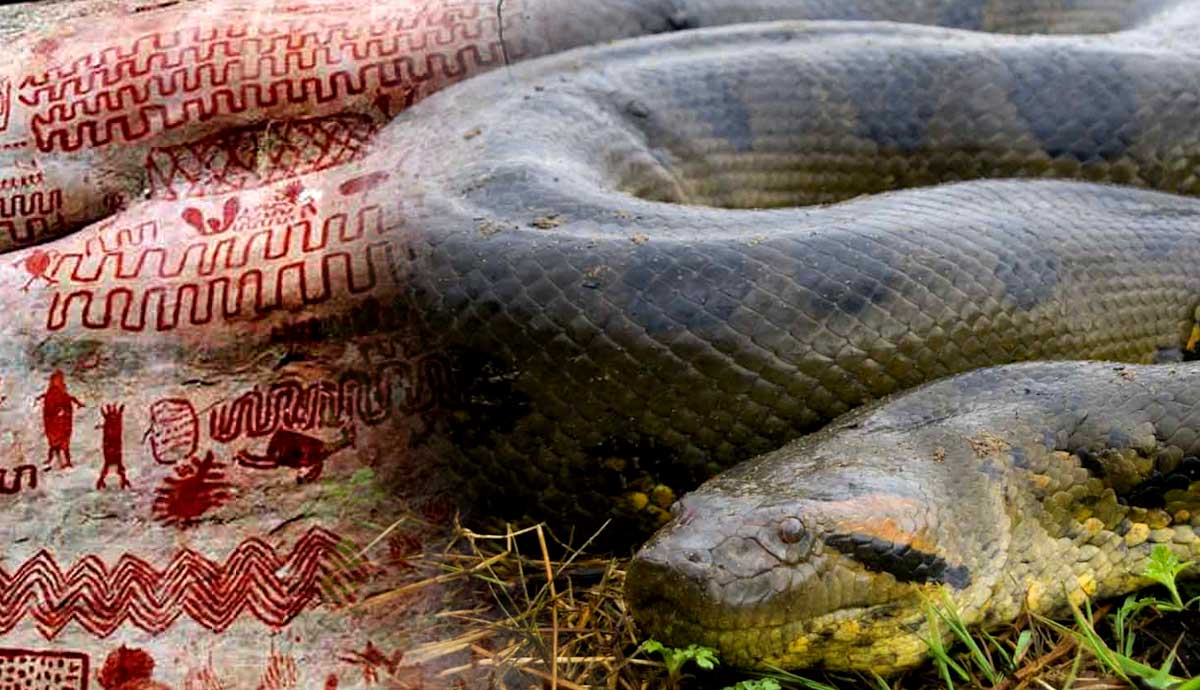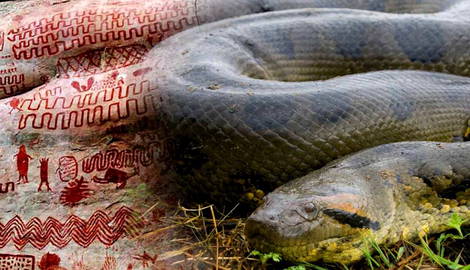
Water is the fundamental element that nourishes the Amazon rainforest. Its rivers are home to a sacred world that gives energy to a complex ecosystem that includes biological, spiritual, and inanimate elements. The waters of the Amazon River and its tributaries are home to the green anaconda, the largest snake in the world. Due to its biological importance, many indigenous communities have incorporated it into their cosmological and mythical stories. Aside from the jaguar, the green anaconda is the animal with the greatest cultural significance among the communities that have historically inhabited the rainforest.
Making a Myth: Why the Green Anaconda?

Different mythical stories about the green anaconda can be found in different locations in the Amazon rainforest. Indigenous communities have associated the shape and nature of the Amazon River with the anaconda because of, on the one hand, its presence in the aquatic landscape of the Amazon, and on the other, because of how the river bends, taking the shape of the curves of a snake. In these communities’ mythical stories and cosmogonic structures, anacondas have been associated with creating the world and humankind, celestial phenomena, and cultural life surrounding water in the tropical rainforest.
In the northwest sector of the forest, specifically in the Colombian region of Vaupés, indigenous communities believe that an ancestral anaconda was the creator of life’s cultural and social order who, through journeying the Amazon River, gave birth to all the communities inhabiting the rivers and tributaries throughout the rainforest. The ancestral anaconda created space and time and distributed the communities alongside the river, teaching them distinctive cultural practices, languages, and beliefs.
The Ancestral Anaconda of the Amazon

The broader anaconda myth explains how an ancestral anaconda was involved in the creation of the universe. The snake started a journey through the waters of the Amazon River, beginning from the Water Doors in the east—also called the Lake of Milk—and heading towards the Vaupés region in the west, “the center of the world.”
The great snake was believed to be at once an animal and a canoe, where all the original human communities embarked. During the creation journey, the anaconda-canoe would emerge from the depths of the waters to the surface to leave ancestral human communities alongside the banks of the river. In some variations of the myth, these were distinct groups of people, including both indigenous peoples and Europeans, demonstrating their historical contact with these communities.
The most significant physical representations of this dual entity have been found in the Serranía del Chiribiquete, a mountainous region in the Colombian Amazon rainforest where ancient pictographs have been found. The anthropologist Castaño-Uribe has described the pictographs as representing anaconda-canoes over which human beings stand and raise their hands to the sky. This suggests a shamanistic relation between veneration practices and the sacredness of the anaconda as one of the most important entities of the Amazon ecosystem.
The myth of the ancestral anaconda varies depending on each community’s linguistic or cultural distinctions. Anthropologist Stephen Hugh-Jones referenced this phenomenon of narrative heterogeneity, describing the myth of the anaconda as a tree with several branches due to the different versions that he found had been recorded.

Among the Desana community in the eastern Amazon rainforest of Brazil, for example, the story describes a boat that was simultaneously a great cobra, or the “grandfather of the world.” This being traveled upriver, and along its trajectory, it stopped at houses next to the waters, leaving entire communities free to enter the houses and perform the first ritualistic ceremonies necessary to settle down and start their social and cultural life.
In the same community, anthropologist Gerardo Reichel-Dolmatoff added that the anaconda-canoe was used by the creator god, the Sun, to send people to the Earth. This story demonstrates a sexual association with the anaconda, as it is also considered the uterus where humans were conceived.
Among the Tukano people, the ancestral anaconda has a double association: one a terrestrial link to the Amazon River and one a supernatural link associated with the Milky Way. The clear sediment left by the Amazon River during the rainy season and the white liquid that seeps from some hallucinogenic plants are associated with the primordial insemination liquids in the story of humankind’s creation. Mythical stories from other communities associate the anaconda with musical instruments, ceramics, healing rituals, and prevalent and popular dualisms of female-male, day-night, or Sun-Moon.
Additional Anaconda Myths

In addition to this story about the origins of the indigenous communities and the world’s creation, mythical associations with the anaconda are found in other regions, specifically in the Peruvian part of the Amazon. This region is home to the Shipibo-Conibo, Ashanika, and Aguaruna peoples. Here, a dangerous mythical anaconda, Yakumama, guards and protects the waters of the Amazon River.
The name Yakumama comes from the Quechua words yaku (agua) and mama (mother), meaning the Mother of Water. The mythical story that made this snake famous in some areas of Bolivia and Peru claims that a giant anaconda used to live undisturbed by humankind. One day, in a time when the rainforest existed in complete harmony, the anaconda was disturbed by a fisherman. Due to the man’s unwelcome presence, Yakumama created a whirlpool from which it emerged, putting the boat and the fisherman in immense danger. Desperate, the man prayed to Inti, the sun god, and asked for help. Eventually, the man managed to flee toward Lake Titicaca, where he could finally escape the dangers of the unexpected encounter.
Other communities tell a different story, narrating how a subtle whipping sound used to be heard coming out from the deep waters. Once, a young warrior from the community, Yahu, went downriver to ask Yakumama the reason for its sorrow. The great snake responded that the lament was because future generations were not going to respect and protect the rainforest. Yahu then decides to join Yakumama and work together to protect the jungle, teaching communities to maintain the balance between all beings inhabiting the forest.
Water is Life: The Centrality of the Amazon River

Different Amazonian stories reflect a profound respect for all the natural and mythological entities that shape the ecological structures of the rainforest. The myths teach values of veneration and protection of the balance between all entities, which should be maintained to safeguard a delicate biological and spiritual order. Myths are also essential in organizing heterogeneous communities with different beliefs, languages, and ritualistic practices. In the myth of the ancestral anaconda, for example, the order in which the communities descended from the snake corresponds to the hierarchical distribution between different people that defines how communities see each other to this day. This ensures a correct system of social, economic, and even kinship exchange between different communities.
Although cultural and geographical aspects specific to each community shape the variations of the myths surrounding the anaconda, the story’s root always refers to the snake’s power as one of the most prominent and most feared and respected animals in the rainforest. The similarities between the snake’s body and the river’s shape reflect how Amazonian communities have preserved strong cosmological narratives that relate the physical phenomena perceived in the environment to their cultural life.

What the myth of the great anaconda truly reveals is the importance of water as a giver of life and as the center of biological and cultural life in the Amazon rainforest. The anaconda’s journey through the Amazon River represents the very route through which all communities were created. The myth of Yacumama talks about the respect that must be paid to the forest and all living beings that are part of it. The anaconda protects the balance of the ecological structures of the forest and represents a silent power that should not be disturbed so as to maintain peace, embodying the nature of the rainforest itself.
Today in Brazil, some of the indigenous communities keeping the myths alive to be passed to newer generations, such as the Desana, are in danger of extinction as their territories are being threatened by the deforestation and displacement caused by intensive exploitation of their land. This has been exacerbated in recent years by the indiscriminate granting of extraction rights to companies looking for natural resources located within ancestral territories. In this context, understanding the local ways of living in harmony with the environment is a way to raise awareness of the threats they are currently facing and to foster support for these communities that, in their isolation, find themselves vulnerable to the dangers of progress and civilization in the Amazon rainforest.
Sources:
- Guida Navarro, Alexandre. (2021). La anaconda como serpiente-canoa: mito y chamanismo en la Amazonía Oriental, Brasil. Boletín de Antropología Vol. 36 No. 61 January-June 2021.
- Cayón, L. (2013). Pienso, luego creo: La teoría makuna del mundo. ICANH. Bogotá.










